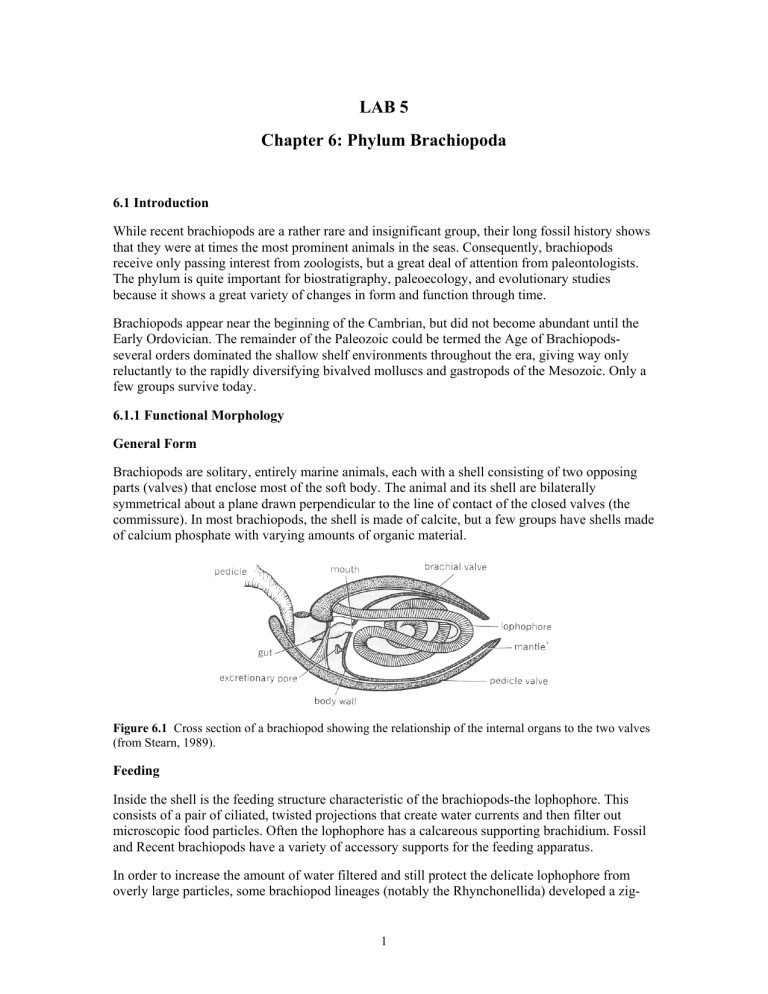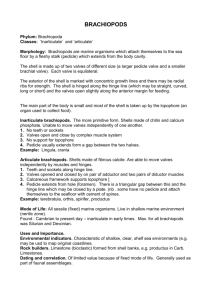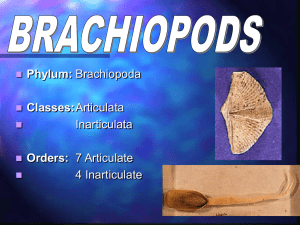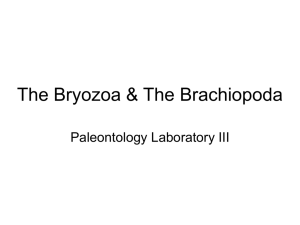Lab 5 - brachiopds

LAB 5
Chapter 6: Phylum Brachiopoda
6.1 Introduction
While recent brachiopods are a rather rare and insignificant group, their long fossil history shows that they were at times the most prominent animals in the seas. Consequently, brachiopods receive only passing interest from zoologists, but a great deal of attention from paleontologists.
The phylum is quite important for biostratigraphy, paleoecology, and evolutionary studies because it shows a great variety of changes in form and function through time.
Brachiopods appear near the beginning of the Cambrian, but did not become abundant until the
Early Ordovician. The remainder of the Paleozoic could be termed the Age of Brachiopodsseveral orders dominated the shallow shelf environments throughout the era, giving way only reluctantly to the rapidly diversifying bivalved molluscs and gastropods of the Mesozoic. Only a few groups survive today.
6.1.1 Functional Morphology
General Form
Brachiopods are solitary, entirely marine animals, each with a shell consisting of two opposing parts (valves) that enclose most of the soft body. The animal and its shell are bilaterally symmetrical about a plane drawn perpendicular to the line of contact of the closed valves (the commissure). In most brachiopods, the shell is made of calcite, but a few groups have shells made of calcium phosphate with varying amounts of organic material.
Figure 6.1
Cross section of a brachiopod showing the relationship of the internal organs to the two valves
(from Stearn, 1989).
Feeding
Inside the shell is the feeding structure characteristic of the brachiopods-the lophophore. This consists of a pair of ciliated, twisted projections that create water currents and then filter out microscopic food particles. Often the lophophore has a calcareous supporting brachidium. Fossil and Recent brachiopods have a variety of accessory supports for the feeding apparatus.
In order to increase the amount of water filtered and still protect the delicate lophophore from overly large particles, some brachiopod lineages (notably the Rhynchonellida) developed a zig-
1
zag commissure. The zig-zags bring the sensitive mantle edges closer together, giving the animal more control over the quality of incoming material (Figure 6.10c shows a zig-zag commissure).
Articulation and valve movement
The most common class of brachiopods, the Articulata, is characterized by the presence of two opposing calcareous valves hinged along the posterior edge. They usually have a series of sockets and teeth which allow valves to open anteriorly for feeding; they can also keep the valves firmly closed when necessary. In some brachiopods the articulating structures have been reduced or lost during evolution.
Two major muscle sets open and close the valves. Diductor muscles attach at one end to the floor of the ventral valve, and at the other end to a projection (cardinal process) in the dorsal valve.
When these muscles contract, the hinge acts as a fulcrum, opening the valves anteriorly. Adductor muscles, which are attached between the floors of both valves, contract to close the valves and hold them shut.
Figure 6.2
Brachiopod valves are opened and closed by pairs of opposed muscles: (A) Contraction of adductors closes the valves; (B) Contraction of diductors levers the shell around the hinge and opens the dorsal valve (Boardman et al. 1987; from Prothero, 1998)
Relation to substrate
Most brachiopods have a fleshy stalk, termed the pedicle, that protrudes posteriorly through one valve or between the valves and attaches permanently to the substrate. When the pedicle exits through a valve (by definition the ventral valve), it leaves an opening that varies greatly in form among brachiopod groups.
2
Figure 6.3
The living brachiopod Magellania . (A) Dorsal view of the shell; (B) Side view showing the pedicle and brachial valve and the position of the pedicle (from Stearn, 1989).
In many the pedicle was lost during either ontogeny or the evolution of the lineage, leaving as evidence a hole partially or completely closed off by accessory plates or growth of the ventral valve.
Some brachiopods had no pedicle and either lived freely on the substrate or attached their ventral valve directly to some firm object. The free-living types developed a wide variety of devices to protect themselves from burial in the sediment or disruption by currents (except for opening and closing the valves and some limited movement on the pedicle, brachiopods are strictly sessile). A few added heavy stabilizing calcite to the posteior and ventral portions of the shell; others had spines that could attach to the substrate or function as a "snowshoe" in muddy areas. Other brachiopods without pedicles were able to grow at a rate that kept the commissure above the sediment surface.
Sensory structures
Recent brachiopods have series of small bristles (setae) extending from grooves at the valve and mantle edges that serve as tactile sensory devices. Many fossil brachiopods have similar grooves, indicating they probably had the same type of system.
Strophomenid brachiopods sometimes have hollow spines which may have carried continuous strips of living mantle tissue from the shell interior to their tips. If so, then the spines would have extended the sensory field of the animal.
6.2 Classification
The brachiopods are divided into two classes, based primarily on shell morphology. The inarticulates have unhinged valves generally of a chitinophosphatic composition, while the articulates are brachiopods with hinged calcareous valves.
6.2.1 *Class Inarticulata
Class Inarticulata contains five orders, only three of which are commonly encountered:
3
*Order Lingulida
• These are the most conservative of the brachiopods; one genus, Lingula, appeared in the
Ordovician and is still alive today in essentially the same form. The shells of lingulids are made primarily of calcium phosphate, which appears dingy brown, and are always biconvex and oval to squarish in outline. The order first appeared in the Cambrian, and it has been found consistently throughout the record. They live burrowed in the soft sediment, anchored by their long pedicle.
Figure 6.5
Lingula , the shell is about 3 cm long. (A) Dorsal view (B) the brachiopod at the top of its burrow attached to the bottom by a long pedicle
Order Acrotretida
• This group has also survived since the Cambrian with a fairly constant shell morphology.
Acrotretid valves are generally subcircular to circular, unequally biconvex, and often have a pedicle opening. An important subgroup (the craniaceans) have no functioning pedicle; instead, they cement the ventral valve directly to the substrate.
Order Obolellida
• These brachiopods resemble the acrotretids and some articulates, and so are rather difficult to identify. Their valves are circular to oval, the ventral one with a pseudointerarea and a pedicle opening of some sort. Obolellids are known only from Cambrian rocks.
6.2.2 *Class Articulata
The articulates are a diverse and complex class. They have proven to be the most useful brachiopods for a variety of studies. Seven orders are recognized.
*Order Orthida
• Apparently the most ancestral of the articulates, these brachiopods are also the most difficult to work with. They are a generalized group lacking complex morphologic features, and they tend to resemble some of the other articulate orders. Orthids are almost always biconvex, with a fairly wide hinge line flanked by distinct interareas on each valve. The first known articulates to appear in the Cambrian are orthids. They change
4
little in basic structure through the Paleozoic, and became extinct at the end of the
Permian.
*Order Pentamerida
• This group usually has strongly biconvex valves that are smooth or finely costate. Their characteristic feature is a robust spondylium, which is a curved calcareous platform for muscle attachment in the beak region. The spondylium is seated in the ventral valve.
Pentamerids probably arose from orthids in the later Cambrian; they went extinct in the
Devonian. The pentamerids were most important in Silurian shelf seas.
*Order Strophomenida
• No other brachiopod order shows as much morphologic diversity as the strophemenids.
Generally, they have plano-convex or concavo-convex shells with a costate surface and no pedicle opening. This simple plan though, has led to several distinct and sometimes exotic forms. They include: o Productids : These brachiopods have hollow spines and strongly concavo-convex shells. They include several large, very spiny brachiopods and specialized reefforming groups. Productids are mostly upper Paleozoic. o "True Strophomenids" : In this group the shell is usually wider than long and the body cavity is small. They are important in the lower Paleozoic, but range into the Jurassic. o Chonetids : These are small shells that resemble the "true strophomenids", but they have hollow spines along the postreior edge. Chonetids are especially prominent in upper Paleozoic rocks. o Oldhaminids : "A leaf in a gravy boat" is the best way to describe the most common oldhaminid genus, Leptodus. These are confined to the Upper Paleozoic and the Lower Mesozoic.
*Order Rhynchonellida
• The shells of this group are strongly biconvex, many to the point of being globose, heavily plicate, and have a very short hinge line. Rhynchonellids are simple internally and have no complicated supports for the brachidium. Most workers believe that they evolved from the pentamerids. The rhynchonellids appeared in the Middle Ordovician and are still extant. Most Mesozoic brachiopods are rhynchonellids.
*Order Spiriferida
• The most common of this group is the easiest to identify: these shells have a hinge line so wide that they look winged. The group is defined by the possession of a spirally-coiled brachidium that "points" toward the cardinal extremities. Most spiriferids are strongly plicate or costate, and they usually bear a fold and sulcus. The group is important in the middle and upper Paleozoic and parts of the lower Mesozoic.
*Order Terebratulida
• These are the most abundant brachiopods today; they are the typical "lamp shells" known to beachcombers. Terebratulid shells are strongly biconvex and bear a short hinge line.
5
The beak is prominent and usually has a rounded pedicle opening. The surface of a terebratulid is smooth or finely costate. This group first appears in Lower Devonian rocks, but it only becomes abundant in Mesozoic and Cenozoic strata.
6.3 Terminology valves lophophore diductor muscle cardinal process setae articulates brachial biconvex fold plicate commissure brachidium adductor muscle pedicle inarticulates spondylium ventral concavo-convex sulcus winged
6.4 Questions
1. Live specimens: (See Appendix for helpful diagrams) a. External examination - sketch and label the following features: pedicle valve, brachial valve, hinge line, interarea, commissure, growth lines, plane of symmetry, pedicle opening b. Internal examination - identify the following features, and know their various functions: mantle, mantle canals, diductor muscles, adductor muscles muscle scars, lophophore, brachidium, pedicle
2. Note and describe how the shape of the brachidium and lophophore is often reflected in the shape of the brachiopod's shell.
6
3. Class Inarticulata, Order Lingulida, Lingula . The morphology of this brachiopod has persisted relatively unchanged since the Cambrian. Note the extensive pedicle. What is Lingula's mode of life? This animal is often referred to as a "living fossil". The hard parts are unchanged since the
Cambrian. Do you think that the soft parts are unchanged?
4. Class Articulata, Order Strophomenida, Suborder Productidina. What morphological feature do the shells of these productids share? What function did these structures serve?
5. Sketch and label the following features:
•
• zig-zag commisure plications
6. Occassionally, internal structures or features may be preserved. What skeletal feature has been preserved in these specimens?
7. Brachiopod shells are described as convex, planar or concave. The shape term for the brachial valve precedes that for the pedicle valve. For example, a brach with a convex brachial valve and a planar pedicle valve is called "convexi-planar". Sketch a cross-section of the following brachiopod shell shapes, labeling brachial and pedicle valves: biconvex, plano-convex, concavoconvex. See Figure 6.8 in the Appendix for help
7
8. Brachiopod classification. The phylum Brachiopoda is divided into two classes, Inarticulata and Articulata. You need to be able to recognize these classes, the important orders within them, and the geological ranges of the classes and orders.
Pick three orders, and make a short list or table of features that might help you distinguish one from the other two orders (shell shape, shell outline, development of ribs, growth lines, size of interarea, length of hinge line, prominence of fold and sulcus, shape of commisure, etc.). Sketches are helpful also.
9. Brachiopods had a variety of modes of life. Match up the specimens with their corresponding mode of life. Make use of shell features, if necessary: a. Lingula 1. epifaunal: free-lying b. a spiny productid 2. epifaunal: attached by pedicle c. Terebratalia 3. d. Spirifer
8
Appendix
Figure 6.6
The basic anatomical orientation and symmetry of brachiopods (Neil and Tucker,1985; from
Prothero, 1998)
Figure 6.7
Terminology of the external features of the brachiopod shell (Neil and Tucker, 1985; Prothero,
1998)
9
Figure 6.8
Cross sections through brachiopod shells, showing curvature. b = dorsal valve; p = pedicle valve. (A) Biconvex, with dorsal valve less convex than ventral; (B) Biconvex, with more convex dorsal valve; (C) Planoconvex; (D) Concavo-convex; (E) Concavo-convex, but more strongly curved; (F)
Strongly convexi-concave; (G) Gently convexi-concave; (H) Resupinate, dorsal valve convex but concave near hinge line; (I) Convexi-planar (Moore et al, 1953; Prothero, 1998).
Figure 6.9
Internal anatomy of a brachiopod, cut along the plane of symmetry (Boardman et al., 1987; from Prothero, 1998)
10
Figure 6.10
Magellania flavescens ; (a) upper surface with brachial valve (x 2 approx.); (b) lateral view (x
2 approx.); (c) anterior view (x 2 approx); (d) in life position, showing pedicle attachment; (e) internal view of pedicle valve (x 2 approx); (f) internal view of brachial valve (x2 approx); (g) larva
((a)-(f) based on Davidson 1851; (g) based on Percival 1944; from Clarkson1979)
11






